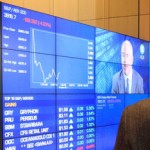Bottom Line for S&P 500 Is Top Line as Price-Sales Ratio Expands

The bottom line for this bull market may turn out to be the top line.
After a six-year run in the Standard & Poor’s 500 Index, corporate revenue, not corporate profits, is flashing red. Judged against sales, the index has reached a level not seen since the aftermath of the Internet bubble.
That’s a big break with price-earnings ratios, which hover around historical averages. Signals emanating from the two indicators are diverging more than any time since at least 1993 and highlight how badly investors need economic data such as last week’s employment report to extend the rally.
“A dollar of earnings is great, whether it comes from cost cutting or revenue growth, but in order to get the next leg of robust growth in stocks, you need to have better sales growth,” Michael Cuggino, who helps oversee $5.7 billion as the president of Permanent Portfolio Family of Funds in San Francisco, said by phone.
The valuation quirk follows six years in which companies struggled to boost revenue while doubling profits via cost cuts and buybacks. Friday’s data highlight the challenge for managers trying to preserve earnings growth at the same time they hire at the fastest rate in 17 years and boost wages.
Valuation Disparity
Following a 204 percent rally since March 2009, the S&P 500 trades at about 19.7 times bottom-line profits, compared with an average of 21.3 since 1980, data compiled by Bloomberg and S&P show. At the same time, the index’s price-sales ratio has risen to about 1.76, the highest since the end of 2000.
The disparity reflects the success companies have had increasing profit margins. The difference between revenue and expenses at non-financial companies in the S&P 500 reached a record 9.2 percent this month, up from 7.2 percent six years ago, data compiled by Bloomberg show.
Thanks to near-record low interest rates, stagnant pay, technology innovations and more than $2 trillion of share buybacks, chief executive officers have increased profit by an average 15 percent a year since 2009, three times faster than sales. Among 323 S&P 500 companies that have reported fourth-quarter results so far, profits climbed 5.7 percent while sales rose 1.1 percent.
Analysts forecast the gap will narrow this year, with profits expanding 2.5 percent and sales rising 2.1 percent, estimates compiled by Bloomberg show. In the first two quarters, both earnings and revenue are poised to contract.
Rising Volatility
“There is some valuation risk in the market,” John Carey, a Boston-based fund manager at Pioneer Investment Management, which oversees about $230 billion, said in a phone interview. “Multiples are not in nosebleed territory like the Internet bubble years, but moderately above average multiples at a time when earnings may not grow.”
Investors are experiencing the most volatile start to a year since 2010 as energy earnings slumped with oil and a stronger dollar hurt sales overseas for companies from Procter & Gamble Co. to Pfizer Inc. The S&P 500 has swung an average 0.92 percent each day, compared with 0.69 percent a year ago.
Anxiety is growing as the Federal Reserve prepares to raise interest rates for the first time since 2006 amid improved employment. The U.S. labor market in January added 257,000 jobs, more than economists forecast, and average hourly earnings jumped the most since November 2008, figures from the Labor Department showed Friday in Washington. While the jobless rate for the overall population was 5.7 percent, the rate of workers who hold a bachelor’s degree or higher sank to 2.8 percent, its lowest level in more than six years.
‘Unimaginable Problem’
“Before long, the U.S. economy is going to run into a problem that was unimaginable just a few months ago: we might run out of people to employ,” Guy LeBas, chief fixed-income strategist at Janney Montgomery Scott in Philadelphia, wrote in a note to clients. “Wage pressures among skilled workers will almost certainly rise further.”
The Fed last month maintained its pledge to be “patient” on the pace of future interest-rate increases. While economists in a Jan. 5-7 Bloomberg survey expected hourly earnings for employees on company payrolls will advance 2 percent to 3 percent on average this year, it’s still short of the 3 percent to 4 percent gains Fed Chair Janet Yellen has said she considers normal with 2 percent inflation.
‘New Normal’
Low borrowing costs and subdued wage growth, as well as a drive by larger companies to move production offshore where labor is cheaper, will sustain profit margins — and that justifies the price-sales multiple, too, according to Dan Miller, director of equities at GW&K Investment Management.
“I’d like to believe that it’s a new normal,” Miller, who helps oversee about $23 billion at GW&K in Boston, said by phone. “We’ve transitioned over the course of the last generation from a high inflation, high interest rate environment to one where concerns should be more regarding deflation. That has the potential to keep corporate profit margins up at high levels.”
A similar divergence between price-sales and P/E ratios coincided with the last market peak and preceded profit contractions. The S&P 500 traded at 1.52 times revenue in 2007 while earnings multiples averaged 17.7. The following year, profit tumbled 78 percent amid the global financial crisis even as sales increased 1.7 percent.
“With the differential being explained by margins, you have to start to question why margins are there, and if that’s sustainable,” Jerry Braakman, chief investment officer of First American Trust in Santa Ana, California, said by phone. His firm oversees $1.1 billion.
“Are we going to have a bear market? Yes. Are we going to have a recession? Yes. The question is always when,” he said. “We’re very long in the tooth in this bull market. You have to have sales growth to make that trick.”
Source: Bloomberg – Bottom Line for S&P 500 Is Top Line as Price-Sales Ratio Expands




























